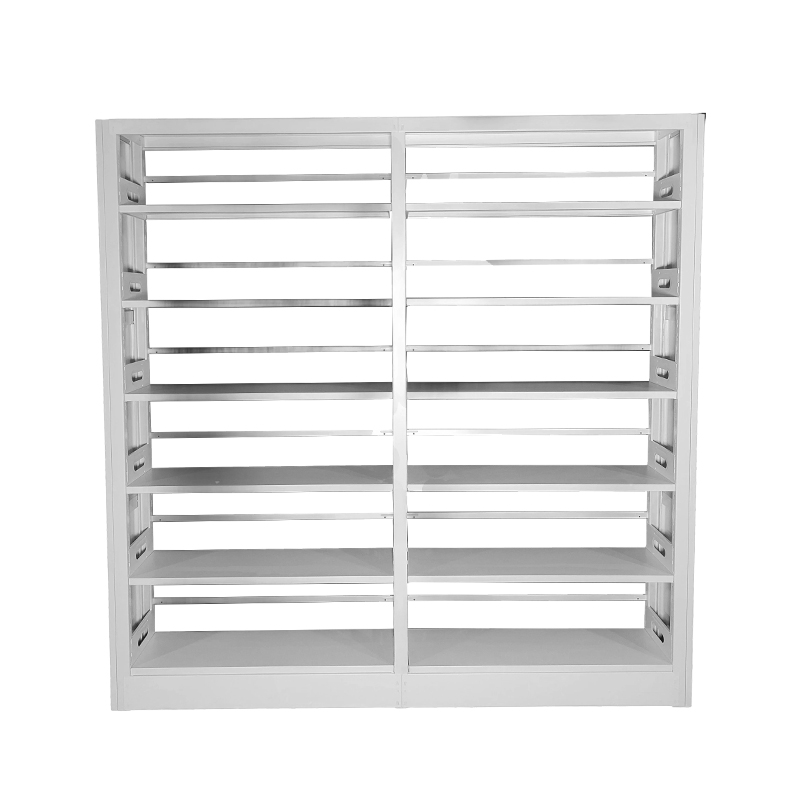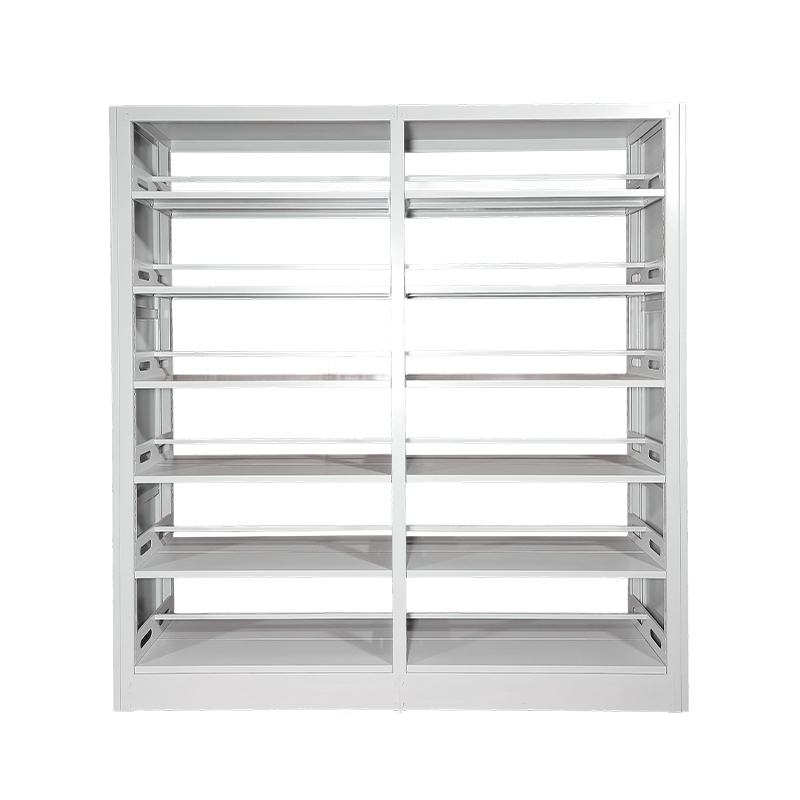How does high-quality cold-rolled steel improve the durability and safety of steel bookshelf?
Release Time : 2025-07-29
High-quality cold-rolled steel plays a crucial role in enhancing the durability and safety of steel bookshelves. This material not only possesses excellent physical properties, but also utilizes advanced manufacturing processes to further enhance its overall performance, ensuring that steel bookshelves remain stable and reliable in a variety of environments.
Firstly, the high strength of cold-rolled steel is a key factor in its durability. Compared to hot-rolled steel, cold-rolled steel undergoes multiple roll-forming processes at room temperature, resulting in a denser grain structure and more uniform internal structure. This microstructural advantage gives the material higher yield strength and tensile strength, enabling it to withstand greater external forces without deformation or fracture. For steel bookshelves, this means that each shelf can stably support a large number of books or other heavy objects, even after long-term use without bending or collapsing, thus ensuring the long-term stability of the structure.
Secondly, the smooth and even surface of cold-rolled steel, with virtually no scale or impurities, provides an excellent foundation for subsequent surface treatment. Electrostatic spraying technology is commonly used to treat the surface of steel bookshelves, creating a durable and aesthetically pleasing protective coating. Due to the high surface quality of cold-rolled steel, the coating adheres more firmly to the surface, resisting peeling or flaking. This not only enhances the bookshelf's appearance but, more importantly, strengthens its corrosion and rust resistance. Even in humid or dusty environments, the bookshelf effectively resists external corrosion, extending its service life.
Furthermore, cold-rolled steel boasts exceptional dimensional accuracy, thanks to the stringent control standards applied during its production. When manufacturing steel bookshelves, precise dimensions ensure a tighter fit between components, reducing looseness or wobble caused by excessive gaps. For example, when connecting the columns to the shelves, precise hole placement and edge treatment ensure that bolts or clips securely lock, avoiding stress concentration points caused by uneven force distribution. This structural stability is directly related to the overall safety and load-bearing capacity of the bookshelf, especially when stacked in multiple layers or fully loaded, where the advantages of high-quality materials are particularly evident.
From a safety perspective, cold-rolled steel also offers excellent flame retardancy. Steel is inherently non-flammable, releasing no harmful gases or flames even in high-temperature environments. This is crucial for preventing the spread of fire. In particular, cold-rolled steel bookshelves, particularly in places like libraries and offices where large quantities of paper materials are stored, can effectively reduce fire risks and safeguard personnel and property. Furthermore, because the material is non-toxic and emits no volatile organic compounds (VOCs), it has no negative impact on indoor air quality, aligning with modern environmentally friendly and healthy living concepts.
Notably, the processability of cold-rolled steel also opens up new possibilities for steel bookshelf design. The use of laser cutting and CNC bending technologies enables manufacturers to perform precise processing tailored to customer needs, achieving complex and precise structural designs. Whether it's the height-adjustable latch holes or the modular joints, high-precision equipment is used to ensure every detail is optimized. This flexibility not only enhances the product's practicality but also increases user convenience during installation and adjustment, further improving the overall user experience.
Finally, the durability of cold-rolled steel is also reflected in its fatigue resistance. In daily use, bookshelves are frequently subjected to loading and unloading, placing high demands on the material's toughness. High-quality cold-rolled steel, after undergoing special treatment, maintains its original properties under repeated stress, making it less susceptible to cracking or fatigue damage. This means that even after years of frequent use, the bookshelf maintains its structural integrity and functionality, eliminating the need for frequent repairs or replacements.
In summary, high-quality cold-rolled steel, with its high strength, precision, excellent surface quality, and outstanding physical and chemical properties, comprehensively enhances the durability and safety of steel bookshelves. It not only provides solid structural support for the bookshelf, but also creates a safe and reliable storage environment through its corrosion-resistant, rust-resistant, flame-retardant, and environmentally friendly properties. With continuous technological advancements, the use of cold-rolled steel will further drive the development of higher-quality steel furniture, satisfying people's pursuit of both functionality and aesthetics.
Firstly, the high strength of cold-rolled steel is a key factor in its durability. Compared to hot-rolled steel, cold-rolled steel undergoes multiple roll-forming processes at room temperature, resulting in a denser grain structure and more uniform internal structure. This microstructural advantage gives the material higher yield strength and tensile strength, enabling it to withstand greater external forces without deformation or fracture. For steel bookshelves, this means that each shelf can stably support a large number of books or other heavy objects, even after long-term use without bending or collapsing, thus ensuring the long-term stability of the structure.
Secondly, the smooth and even surface of cold-rolled steel, with virtually no scale or impurities, provides an excellent foundation for subsequent surface treatment. Electrostatic spraying technology is commonly used to treat the surface of steel bookshelves, creating a durable and aesthetically pleasing protective coating. Due to the high surface quality of cold-rolled steel, the coating adheres more firmly to the surface, resisting peeling or flaking. This not only enhances the bookshelf's appearance but, more importantly, strengthens its corrosion and rust resistance. Even in humid or dusty environments, the bookshelf effectively resists external corrosion, extending its service life.
Furthermore, cold-rolled steel boasts exceptional dimensional accuracy, thanks to the stringent control standards applied during its production. When manufacturing steel bookshelves, precise dimensions ensure a tighter fit between components, reducing looseness or wobble caused by excessive gaps. For example, when connecting the columns to the shelves, precise hole placement and edge treatment ensure that bolts or clips securely lock, avoiding stress concentration points caused by uneven force distribution. This structural stability is directly related to the overall safety and load-bearing capacity of the bookshelf, especially when stacked in multiple layers or fully loaded, where the advantages of high-quality materials are particularly evident.
From a safety perspective, cold-rolled steel also offers excellent flame retardancy. Steel is inherently non-flammable, releasing no harmful gases or flames even in high-temperature environments. This is crucial for preventing the spread of fire. In particular, cold-rolled steel bookshelves, particularly in places like libraries and offices where large quantities of paper materials are stored, can effectively reduce fire risks and safeguard personnel and property. Furthermore, because the material is non-toxic and emits no volatile organic compounds (VOCs), it has no negative impact on indoor air quality, aligning with modern environmentally friendly and healthy living concepts.
Notably, the processability of cold-rolled steel also opens up new possibilities for steel bookshelf design. The use of laser cutting and CNC bending technologies enables manufacturers to perform precise processing tailored to customer needs, achieving complex and precise structural designs. Whether it's the height-adjustable latch holes or the modular joints, high-precision equipment is used to ensure every detail is optimized. This flexibility not only enhances the product's practicality but also increases user convenience during installation and adjustment, further improving the overall user experience.
Finally, the durability of cold-rolled steel is also reflected in its fatigue resistance. In daily use, bookshelves are frequently subjected to loading and unloading, placing high demands on the material's toughness. High-quality cold-rolled steel, after undergoing special treatment, maintains its original properties under repeated stress, making it less susceptible to cracking or fatigue damage. This means that even after years of frequent use, the bookshelf maintains its structural integrity and functionality, eliminating the need for frequent repairs or replacements.
In summary, high-quality cold-rolled steel, with its high strength, precision, excellent surface quality, and outstanding physical and chemical properties, comprehensively enhances the durability and safety of steel bookshelves. It not only provides solid structural support for the bookshelf, but also creates a safe and reliable storage environment through its corrosion-resistant, rust-resistant, flame-retardant, and environmentally friendly properties. With continuous technological advancements, the use of cold-rolled steel will further drive the development of higher-quality steel furniture, satisfying people's pursuit of both functionality and aesthetics.





